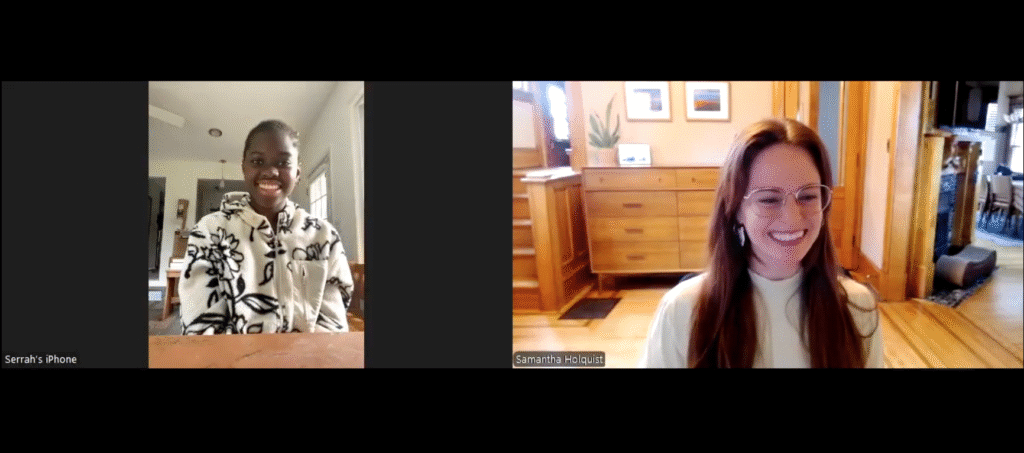SUSTAINING STUDENTS AND TEACHERS AS CHANGE AGENTS IN A RESEARCH-PRACTICE PARTNERSHIP

Student engagement in math is often viewed through a narrow lens, typically defined by grades, homework completion, or standardized test scores. But what happens when students and teachers shape how we define and measure math engagement?
Over the past three years, Child Trends, Search Institute, McREL International, and Bloomington Public Schools—a large suburban school district just outside Minneapolis, Minnesota—partnered to examine and improve how student engagement in math is understood and measured. The Adapted Measure of Math Engagement (AM-ME) project brought together a cross-disciplinary research-practice partnership of five students, five teachers, four district staff, and eight researchers—jointly known as the AM-ME Research Group—to adapt an existing engagement measure to better reflect students’ experiences, with a special focus on Black and Latino students who are often underrepresented in STEM fields. The AM-ME Research Group met regularly throughout the academic year, with at least four meetings each in the fall and spring, to co-design and carry out an iterative, mixed-methods research process. Together, we developed and implemented research activities, analyzed qualitative and quantitative data, and tested whether the revised measure validly and equitably captured how students think, feel, and perform in their math courses.
What began as a technical effort to adapt a measure became a powerful example of what is possible when students and teachers are treated as partners. The work showed us how to sustain partnership engagement over time, what participants gained, and how they hope their contributions lead to meaningful change in their school district. We share some key insights from these three areas here and hope these can be useful for others working to center student and teacher voice in their partnership efforts.
HEAR DIRECTLY FROM TWO AM-ME RESEARCH GROUP MEMBERS
In a brief video accompanying this article, you can hear directly from two members of the research group: AM-ME Research Group high school student, Serrah Ssemukutu, and researcher, Samantha Holquist, discuss their work together as part of the research-practice partnership. We invite you to watch it below and then keep reading for more detailed insights!

SUSTAINING STUDENT AND TEACHER ENGAGEMENT IN THE PARTNERSHIP THROUGH RELATIONSHIPS AND PURPOSE
In the AM-ME project, students and teachers remained actively involved for three years. This sustained engagement was made possible by a structure that emphasized trust, collaboration, and shared purpose.
Meetings were designed to support both productivity and connection. Each session included structured co-design activities alongside informal opportunities to build relationships. Small group discussions, interactive tools like easel-sized Post-its, and collaborative data analysis allowed participants to engage in multiple ways. Sharing meals and holding space for informal conversation also helped foster a sense of belonging.
Students and teachers were treated as partners from the start. They led feedback sessions, co-developed survey items, and analyzed data with researchers and district staff. Having a familiar peer, teacher, or colleague in the partnership helped members feel more comfortable early on, which built momentum and trust across the full team.
Students and teachers said they stayed involved because the work was meaningful. Students believed the project could improve the math experiences of their peers, particularly those who often felt unseen. One student said, “I loved working on something I care about with others who also care.” A teacher noted, “I cared about seeing changes. This will help the kids we need to help.”
These practices helped shift the project from an academic task to a shared journey. Students and teachers did not just participate. They took ownership.
GROWTH THROUGH SHARED LEARNING BETWEEN STUDENTS AND TEACHERS
Engagement in the project led to growth for both students and teachers.
Students gained a deeper understanding of what engagement in math really means. Many initially thought disengagement stemmed from lack of effort. Over time, they came to see it as shaped by classroom dynamics, relationships, and feelings of belonging. One student reflected, “It’s more complex than I thought. I used to think it’s just students who don’t put in the work, now I know it’s a collective effort.”
Students also built skills in designing surveys, analyzing data, and presenting findings. They learned to collaborate in mixed groups, listen actively, and communicate across differences. Importantly, they realized they were not alone in their experiences. “I’m more engaged in math than I thought,” one student said. “And I’m not the only one who struggles.”
Teachers also reported new insights. They described gaining a clearer understanding of why students disengage and how experiences vary across racial and cultural groups. One teacher shared, “I’ve always known relationships matter, but this project helped me better understand why some students feel left out and how to be more responsive.”
The experience strengthened teachers’ empathy and reinforced the importance of student voice. “I need to put even more effort into understanding these kids,” one teacher said.
STUDENTS AND TEACHERS ENVISIONING SYSTEM CHANGE
Students and teachers wanted the work to lead to real, lasting change.
Students recommended using infographics and short presentations to make data accessible and proposed dedicating time during professional development to explore findings. They stressed the need for specific, actionable strategies. Rather than general advice to “build relationships,” students wanted teachers to have examples of what that looks like in practice.
Teachers echoed this. They wanted time, tools, and support to reflect on their teaching and understand how classroom structures influence engagement. Several said the collaboration helped them better understand students' perspectives.
Both groups emphasized the need to involve families and peers in sharing the findings of the partnership. Suggestions included translating materials into other languages, hosting family nights, and using the data to guide classroom discussions about norms and support. Students wanted peers to know they were not alone and to feel empowered to speak up.
When asked what they hoped to see in math classrooms, students called for stronger teacher-student connections, more visible support, and learning environments that reflect diverse needs. “I hope to see my teachers being more open to students with different learning strategies,” one student said. Teachers also expressed a desire to build more inclusive classrooms and better support Black and Latino students. To honor these insights, we will begin translating these hopes into action by supporting implementation efforts across schools and classrooms starting next school year.
Together, students and teachers called for a system that listens, reflects, and grows, where engagement is not just measured but nurtured.
FINAL REFLECTIONS
The Adapted Measure of Math Engagement project is a reminder that educational research is most effective when it centers those most affected. By creating space for students and teachers to shape every step of the process—from question design to data use—we developed more than a measure. We helped build a stronger foundation for student- and teacher-centered improvement.
With the right structures in place, students and teachers are not just participants. They are partners and change agents.
To explore the project and learn more about our approach, visit the project page.
Samantha E. Holquist is Program Area Director of Education at Child Trends; Alyssa Scott is Research Scientist at Child Trends; Diane (Ta-Yang) Hsieh is Research Scientist at Search Institute; Olivia Reyes is Senior Research Analyst at Child Trends, Marisa Crowder and Mark Vincent B. Yu are Senior Researchers at McREL International, and Claire Kelley is Program Area Director of Data Science and Senior Data Scientist at Child Trends.
The Adapted Measure of Math Engagement Research Group includes six students (Antonio Chavira, Brianna Espy, Ryan Ombongi, Serrah Ssemukutu, Salma Ahmed, and Diamond Tony-Uduhirinwa), five teachers (Nathan W. Earley, Karina Mazurek, Kathleen Morgan, Karla Rokke, and Ashly Tritch), and five researchers (Marisa Crowder, Samantha E. Holquist, Diane (Ta-Yang) Hsieh, Claire Kelley, and Mark Vincent B. Yu). Researchers Alyssa Scott, Olivia Reyes, and Avalloy McCarthy also extensively contributed to this work. Bloomington Public School District leaders Betsy Hawes, Marcie Coval, Julio Caesar, and Rik Lamm provided support to this work. Jennifer Widstrand served as the project manager.
If you have questions about the Adapted Measures of Math Engagement project, please contact Principal Investigator Samatha E. Holquist at sholquist@childtrends.org.
This project is funded by the National Science Foundation, grant #2200437. Any opinions, findings, and conclusions or recommendations expressed in these materials are those of the author(s) and do not necessarily reflect the views of the National Science Foundation.
Suggested citation: Holquist, S. E., Scott, A., Hsieh, D., Reyes, O., Crowder, M., Yu, M. V. B., Kelley, C., & the Adapted Measure of Math Engagement Research Group. Sustaining Students and Teachers as Change Agents in a Research-Practice Partnership. NNERPP Extra, 7(3), 23-27. https://doi.org/10.25613/KPXS-7H04
